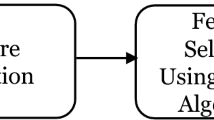Abstract
Parkinson’s disease is one of the most destructive diseases of the nervous system, affecting sound faster and more than any other subsystem of the body. Over the past decade, researchers have studied Parkinson’s disease by analyzing audio signals. It is a low-cost method that eliminates the need for the patient to be physically present at the clinic. By recording the sound signal from the pronunciation of the words and then extracting the appropriate features from them, it is possible to identify the disturbance in the sound movements of the person with Parkinson’s. Therefore, the ability to diagnose the disease before other clinical symptoms will be available. This paper examines the disability caused by Parkinson’s voice disorder and extracts parameters from the audio signal that well illustrate the disabilities in the voice. The proposed method uses a sparse representation algorithm to reduce the dimensions of the feature. At this stage, the best features are extracted from the person’s voice and appearance. Then, the resulting properties are sent as input to the sparse code classifiers. The accuracy of the proposed method for approximate message passing (AMP) classifiers is 99.11%. Evaluation of the proposed method shows that it has reduced storage space, in addition to increasing the efficiency of detection compared to the other methods.




Similar content being viewed by others
References
Altay, E. V., & Alatas, B. (2020). Association analysis of Parkinson’s disease with vocal change characteristics using multi-objective metaheuristic optimization. Medical Hypotheses, 141, 109722.
Oung, Q. W., et al. (2015). Technologies for assessment of motor disorders in Parkinson’s disease: A review. Sensors, 15(9), 21710–21745.
Tsanas, A. (2019). New insights into Parkinson’s disease through statistical analysis of standard clinical scales quantifying symptom severity. In 41st Annual International Conference of the IEEE Engineering in Medicine and Biology Society (EMBC).
Lahmiri, S., & Shmuel, A. (2019). Detection of Parkinson’s disease based on voice patterns ranking and optimized support vector machine. Biomedical Signal Processing and Control, 49, 427–433.
Chen, Y. S., et al. (2020). Identification of the framingham risk score by an entropy-based rule model for cardiovascular disease. Entropy, 22(12), 1406.
Chen, H. L., et al. (2016). An efficient hybrid kernel extreme learning machine approach for early diagnosis of Parkinson’s disease. Neurocomputing, 184, 131–144.
Emamzadeh, F. N., & Surguchov, A. (2018). Parkinson’s disease: Biomarkers, treatment, and risk factors. Frontiers in Neuroscience, 12, 612.
Shahbakhi, M., Far, D. T., & Tahami, E. (2014). Speech analysis for diagnosis of parkinson’s disease using genetic algorithm and support vector machine. Journal of Biomedical Science and Engineering, 7(4), 147–156.
Avci, D., & Dogantekin, A. (2016). An expert diagnosis system for parkinson disease based on genetic algorithm-wavelet kernel-extreme learning machine. Parkinson’s Disease, 2016, 5264743.
Zhang, H. H., et al. (2016). Classification of Parkinson’s disease utilizing multi-edit nearest-neighbor and ensemble learning algorithms with speech samples. Biomedical Engineering Online, 15(1), 122.
Gil-Martín, M., Montero, J. M., & San-Segundo, R. (2019). Parkinson’s disease detection from drawing movements using convolutional neural networks. Electronics, 8(8), 907.
Mostafa, S. A., et al. (2019). Examining multiple feature evaluation and classification methods for improving the diagnosis of Parkinson’s disease. Cognitive Systems Research, 54, 90–99.
Singh, M., & Pati, D. (2019). Combining evidences from Hilbert envelope and residual phase for detecting replay attacks. International Journal of Speech Technology, 22(2), 313–326.
Kadam, V. J., & Jadhav, S. M. (2019). Feature ensemble learning based on sparse autoencoders for diagnosis of Parkinson’s disease. Computing Communication and Signal Processing, 810, 567–581.
Farsi, H., Nasiripour, R., & Mohammadzadeh, S. (2018). Eye gaze detection based on learning automata by using SURF descriptor.Information Systems & Telecommunication, 41.
Liu, Y., Liu, S., & Wang, Z. (2015). A general framework for image fusion based on multi-scale transform and sparse representation. Information Fusion, 24, 147–164.
Jiao, J., Zhao, M., Lin, J., & Liang, K. (2019). Hierarchical discriminating sparse coding for weak fault feature extraction of rolling bearings. Reliability Engineering & System Safety, 184, 41–54.
Nasiripour, R., Farsi, H., & Mohamadzadeh, S. (2019). Visual saliency object detection using sparse learning. IET Image Processing, 13(13), 2436–2447.
Sezavar, A., Farsi, H., & Mohamadzadeh, S. (2019). Content-based image retrieval by combining convolutional neural networks and sparse representation. Multimedia Tools and Applications, 78(15), 20895–20912.
Little, M., et al. (2008). Suitability of dysphonia measurements for telemonitoring of Parkinson’s disease. Nature Precedings.
Zham, P., et al. (2017). Efficacy of guided spiral drawing in the classification of Parkinson’s disease. IEEE Journal of Biomedical and Health Informatics, 22(5), 1648–1652.
Kotsavasiloglou, C., et al. (2017). Machine learning-based classification of simple drawing movements in Parkinson’s disease. Biomedical Signal Processing and Control, 31, 74–180.
Gallicchio, C., Micheli, A., Pedrelli, L. (2018). Deep echo state networks for diagnosis of parkinson’s disease. arXiv:1802.06708
Khatamino, P., Cantürk, İ., & Özyılmaz, L. (2018). A Deep Learning-CNN Based System for Medical Diagnosis: An Application on Parkinson’s Disease Handwriting Drawings. In 2018 6th International Conference on Control Engineering & Information Technology (CEIT)
Gunduz, H. (2019). Deep learning-based parkinson’s disease classification using vocal feature sets. IEEE Access, 7, 115540–115551.
Mohamed, G. S. (2016). Parkinson’s disease diagnosis: Detecting the effect of attributes selection and discretization of parkinson’s disease dataset on the performance of classifier algorithms. Open Access Library Journal, 3(11), 1–11.
Zwartjes, D. G., et al. (2010). Ambulatory monitoring of activities and motor symptoms in Parkinson’s disease. IEEE Transactions on Biomedical Engineering, 57(11), 778–2786.
Rigas, G., et al. (2012). Assessment of tremor activity in the Parkinson’s disease using a set of wearable sensors. IEEE Transactions on Information Technology in Biomedicine, 16(3), 478–487.
Cancela, J. (2010). A comprehensive motor symptom monitoring and management system: the bradykinesia case. In 2010 Annual International Conference of the IEEE Engineering in Medicine and Biology
Arrigo, A., et al. (2017). Visual system involvement in patients with newly diagnosed Parkinson disease. Radiology, 285(3), 885–895.
Author information
Authors and Affiliations
Corresponding author
Rights and permissions
About this article
Cite this article
Mohamadzadeh, S., Pasban, S., Zeraatkar-Moghadam, J. et al. Parkinson’s Disease Detection by Using Feature Selection and Sparse Representation. J. Med. Biol. Eng. 41, 412–421 (2021). https://doi.org/10.1007/s40846-021-00626-y
Received:
Accepted:
Published:
Issue Date:
DOI: https://doi.org/10.1007/s40846-021-00626-y




